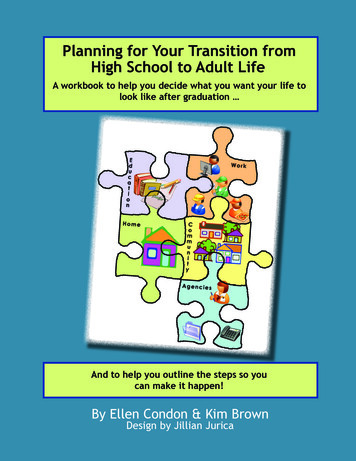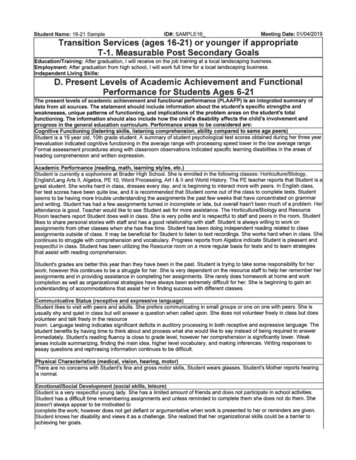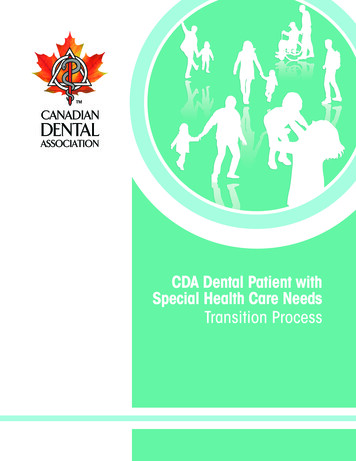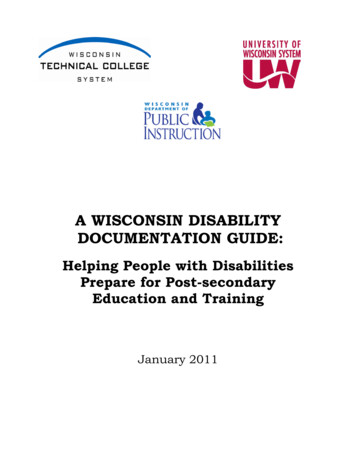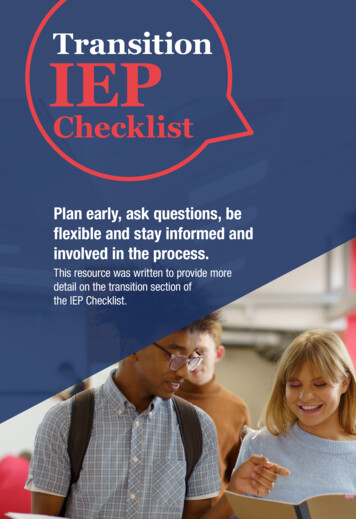
Transcription
TransitionIEPChecklistPlan early, ask questions, beflexible and stay informed andinvolved in the process.This resource was written to provide moredetail on the transition section ofthe IEP Checklist.
An Introduction to Transition T ransition refers to the process of movingfrom high school to the adult world. Beginningat age, all students who have IEPs arerequired to have transition goals developedeach year during their IEP meeting. There are two required types of transitiongoals: employment and post-secondaryeducation/training. The third goal area isindependent living, which is recommended.Transitionisn’t just onemeeting, it’san ongoingprocess onceyour childreaches theright age. These goals are developed using transitionassessments, which are tools that helpstudents identify their strengths, interests,skills, and/or knowledge needed to reach theirgoals for life after high school.BEFORETHETRANSITIONIEP MEETINGBefore theTransition IEP MeetingWhat Parents Need to Know Required IEP team members include a parent or guardian, specialeducation teacher, regular education teacher, administrativerepresentative (also known as the LEA). If an evaluation has takenplace, someone such as a school psychologist who can interpretthe results is also required.
The student is required to be invited at ageencouraged but not required to attend.and older and Others who may be invited to the meeting, especially if theyprovide services to the child, may include a school transitioncoordinator, vocational rehabilitation, counselor, or someone froman adult day services program. The school or parent may inviteoutside agencies. For outside agencies to participate, parentsmust agree in writing. Just as with previous IEP meetings, you have the right to ask for adraft of the transition IEP before the meeting.Parents: It might be useful to ask yourselfsome of these questions:- What activities does my child enjoy?- What is your child good at?- What types of chores does your child doaround the house?- Where do you see your child living as anadult? Who are they living with?- How will your child travel to where they needto go?- Will your child need a guardian?- Where will your child get the money on whichto live?Thinking about what life will be like for your child after highschool can be exciting and challenging at the same time. Yourchild’s transition IEP needs to have things in it that will helpyour family plan for success.
Before the Transition IEP MeetingWhat Students Need to Know Every year when you areor older, teachers at your school willask you questions about what you may want to do for a job orcareer, if you want to continue to go school after high school andwhat you might want to study, and ways you’d like to becomemore independent. Sometimes you will be asked to fillout questions on a form about whatyou’d like to do after high school. Othertimes it will be more like a discussionbetween you and your teachers. Be honest when you answer yourteacher’s questions. Your goals afterhigh school need to be based on yourstrengths, needs, interests,and preferences.There are noright or wronganswersand youare allowedto changeyour mind! When you turnyou are required to be invited to your IEPmeeting. It is up to you if you want to attend. If you are unsurewhether to go, you may want to talk to a parent or someone youtrust about why you feel that way. You can participate in your IEP meeting in many ways. You canattend in person, record videos of how you feel, draw pictures ofwhat you like, write down lists of things that are important to you.Remember: Thebest way for otherson your IEP teamto know whatyour goals are isfor YOU to sharethem. There is nowrong way to bea part of your ownIEP meeting.BESTPRACTICE:Youth, parents, andeducators shoulddevelop a draft ofyour transition goalsfor the transitionIEP meeting.
DURINGTHETRANSITIONIEP MEETINGDuring theTransition IEP MeetingTips for Parents Bring your ideas and any goals you’d like to suggest to the IEPmeeting. Also, bring any important outside documentation suchas neuropsychological evaluations, vocational assessments, ortherapist’s recommendations. If new team members are present, make sure they introducethemselves and clarify their role(s) in the meeting. Ask the school to share or project the IEP if necessary, soeveryone sees any changesbeing made as they happen. If you have any questionsabout the assessments or thecontents of the IEP, make sureto ask. If there are any differencesbetween what the school issuggesting for postsecondarygoals, course of study, ortransition services and whatyou’d prefer for your child, saysomething. This will allow youto discuss the reasons.Independent livinggoals are optional,but if you feelstrongly your childneeds one, use anindependent livingskills checklistto ensure the IEPteam’s decision isbased on data.
Be your child’s best advocate, but don’t speak for him or her. Ifyour child chooses not to attend the meeting, keep in mind thatthe transition IEP should still be based on his or her strengths,interests, needs, and preferences. Share those as muchas possible. Make sure to consider goals for developing your child’s selfadvocacy skills. This is an important part of the transition process. If your child does participate in the IEP meeting and reveals adifferent vision of the future than you have, embrace it. It’s OK tohave concerns, but your child needs your support.NOTEStudent rights are transferredto the student at age 18 (theage of majority). To continueto participate in your child’sIEP and have decision-makingrights, permission must begiven by the student.During the Transition IEP MeetingTips for Students You are the most important member of the IEP team.This is your IEP your life your future. Challenge yourself. If you feel confident and feel ready, takethe lead! Participate in the meeting in whatever way is comfortable for you,even if only for a few minutes. The adults in the room need to hearfrom you!
Challenge your team to be creative and find ways to include youin the meeting. Your participation could be through videos, lettersyou write, drawings and more! Come prepared to share what you like about school, what you aregood at, what accommodations work for you, what you need helpwith etc. Share your future goals and plans. Share them with someonebefore the meeting if speaking at the meeting is not something youwant do. Don’t be afraid to ask questions if things are moving too fast or ifyou don’t understand something. The members of your IEP team care about your well-being andyour future, be sure to thank them for their support.
AFTERTHETRANSITIONIEP MEETINGAfter theTransition IEP MeetingTips for ParentsCongratulations, you have completed an important step in yourchild’s transition planning. Now, the hard work begins. Transition isn’t just an exercise at the annual IEP meeting. Stayengaged in it throughout the high school years, especially as itgets closer to graduation. Keep in mind that your child’s transition IEP is a legal documentand is a work in progress. Expect that at least some of your child’s postsecondary goals willchange based on his or her interests. This is often a good thing. Seek support from new sources when appropriate. Encourage yourchild to try different courses, develop new vocational skills, andeven attempt new extracurricular activities. Don’t be discouraged if you don’t succeed right away. Trial and error are encouraged. This is how everyone involvedin the transition planning process will learn more about how tosupport your child.
If your student applies to a college and/or for services fromstate agencies such as vocational rehabilitation, a Summary ofPerformance (SoP) may be necessary. The SoP documents achild’s academicachievementand functionalperformance, includingrecommendations onhow to assist the childin meeting the child’spostsecondary goals. The parent/guardian andthe student will receive acopy of the SoP during thefinal year of a student’shigh school education. The IEP team needs to beworking on a Summaryof Performance (SoP)at each IEP meetingthroughout high school.Prior to graduation, theSoP should only need a brief update.SoP should include:- Information aboutthe student- A summaryof academicachievementand functionalperformance- Recommendationsabout how toassist the studentin meeting postsecondary goals- Student perspective Be sure your child understands the information and keeps a copyof the SoP. Ensure ALL your child’s teachers and support staff areaware that a transition IEP has been completed for the next12 months.Keep your child motivated to do the things theyare responsible for in the IEP by reminding themwhat those are, supporting their success, andencouraging them through struggles.
After theTransition IEP MeetingTips for Students Be aware of what your Transition Plan says and which parts youare responsible for. Speak up to your teachers and family if you need help doing someof these things. When your goals after high school change, tell your family,teachers, and any other trusted adult who is supporting you. Don’tbe shy- it is your future and you are allowed to change your mind! Practice making your own choices daily. Work on skills that will help you get a job, such as being on time,getting along with others, and meeting deadlines. Take classes, participate in activities and groups, and look forvolunteer experiences based on your interests that will help youmeet people who can help you reach your goals. Practice independent living skills like cleaning, cooking, and otherhousehold chores.
Health care is an important part ofyour future too. You could practicemaking your medical appointmentsand arranging transportation. Research educational options thatmatch your interests and practicefilling out applications. Research jobs matching your skillsand interests. Practice filling outapplications as you prepare to apply. Research possible jobaccommodations so you knowwhat help you might need on thejob. Practice telling others aboutyour disability so that you will knowwhen and how to advocate foraccommodations on the job and/orin school. This is called disclosingyour disability.The moreideas youcontributeand the moreexperiencesyou try duringtransitionplanning,the moremotivated youwill be to takecharge ofyour future.
ADDITIONALRESOURCESAdditional transition resources: Think College (national) Building Self Advocacy Student Rubric for IEP Participation When Your Child Turns 18 GPAEA Independent Living Skills Checklist National Parent Center on Transition and Employment IRIS Center IEP Transition Services Worksheet The Arc’s Self-Determination Scale Transition Assessment Tools Transition Goals in the IEPThis resource was produced for Project Launch by WI FACETS under a cooperative agreement with the USDepartment of Education (H235F200010). Project Launch is a project of PACER Center and is funded by theUS Department of Education’s Rehabilitation Service Administration. The contents of this document do notnecessarily represent the policy of the Department of Education and should not assume endorsement by thefederal government.
When you turn you are required to be invited to your IEP meeting. It is up to you if you want to attend. If you are unsure whether to go, you may want to talk to a parent or someone you trust about why you feel that way. You can participate in your IEP meeting in many ways. You can



